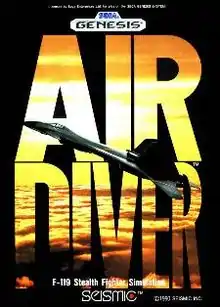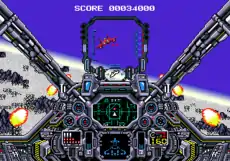Air Diver
Air Diver: F-119 Stealth Fighter Simulation (エアダイバー) is a combat flight simulator video game released by Seismic (Asmik Ace Entertainment in Japan) in April 1990 for the Sega Genesis/Mega Drive console. It is notable as being one of the two first third party published titles for the console in North America. A follow-up, Super Air Diver was released exclusively for the Super Nintendo Entertainment System years later.
| Air Diver: F-119 Stealth Fighter Simulation | |
|---|---|
 North American cover art | |
| Developer(s) | Copya System |
| Publisher(s) | Seismic (Asmik Ace Entertainment in Japan) |
| Series | Air Diver |
| Platform(s) | Sega Genesis |
| Release | |
| Genre(s) | Combat flight simulator |
| Mode(s) | Single-player |
Summary

This video game is a combat flight simulator similar to After Burner, except the game is played in a first-person view (from inside the cockpit). Gameplay involves flying the fictional F-119D Stealth Fighter against the enemy forces. A terrorist organization stationed out of the Middle East is waging a constant battle against U.S. forces; backed by several hostile governments including the Soviet Union (Although the back of the US package says that the terrorists are backed by extraterrestrial beings). Players must use their stealth abilities in order to evade detection and create a global free society out of a world tormented by the oppressive anti-American regimes.
Boss fights are similar to those found in arcade combat flight simulator games. The score in the game is tabulated in a similar style to similar games found in video arcades. Missions can take place either during the day or during the night.
Reception
| Publication | Score |
|---|---|
| IGN |
Air Diver received mixed to poor reviews. EGM's reviewers were perhaps the most positive, giving it decent grades of 6 and 7, praising the detailed art but criticizing the repetitive gameplay and choppy scrolling.[1] French magazine Micro News gave it a "garbage" rating, calling it a "pale copy of After Burner" and "hopelessly, doubtlessly worthless."[2] Similarly, German magazine Power Play said it "looks like a dusty propeller plane" when compared to After Burner, and "not a good debut for Asmik", rating it 37%.[3]
References
- "Review Crew". Electronic Gaming Monthly (10). Sendai Publishing. May 1990.
- "Tops & softs - consoles". Micro News (34). May 1990.
- "Videospiele". Power Play (7–1990). June 1990.